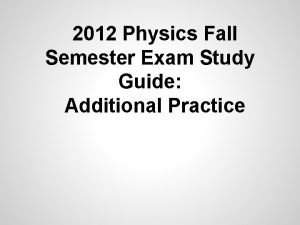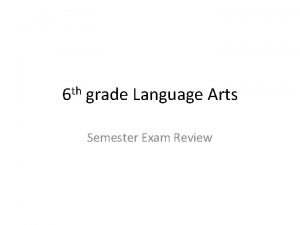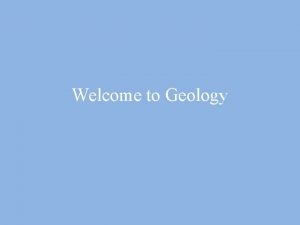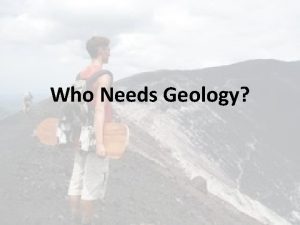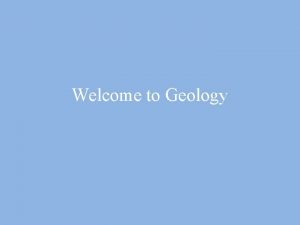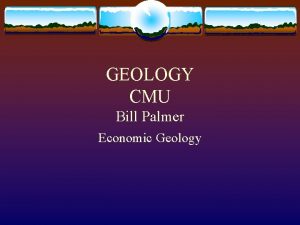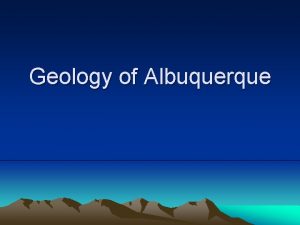Final Exam Review Fall 2011 Geology 1403 Final









- Slides: 9

Final Exam Review Fall 2011 Geology 1403 Final Exam Wednesday December 14 th

Chapter 15 Shoreline Systems • • Wave height, frequency & wavelength Waves are circular shorten when they reach the shoreline Waves get energy from wind The energy moves, not the water per se Longshore drift Erosional Features – – sea cave sea arch sea stack sea cliff – wave-cut platform Depositional features – – – • Atolls – – • Fringing reef barrier reef Tsunami – • • tombolo beach barrier island baymouth bar spit characteristics Primary and Secondary Beaches deltas. offshore islands, bays and estuaries barrier bars and spits. • Tides • Caused by sun and moon • • • Ebb neap Mostly caused by moon

Chapter 16 Eolian Systems • Wind Transport – – • rolling saltation sliding suspension Erosional Features/Products – – – yardang deflation rock ventifact loess Desert pavement • • Know new cause- bacteria Erosional Elements (Causes) – – chemical weathering. wind running water-primary erosional agent sand blasting • Sand Dunes – longitudinal – parabolic (blowout) – barchan (constant wind, not enough sand) – transverse (lots of sand) – star

Chapter 17 Plate Tectonics • • • – – – Evidence for Plate Tectonics – – – structural geology. paleoclimatology. paleontology. paleomagnetism geographic fit • the first to recognize the significance of the "fit" of the Atlantic coasts of Africa and South America? – Antonia Snider-Pellegrini • • Plate tectonic theory postulates – – lithospheric blocks move continental crust is broken into large fragments. old lithosphere is destroyed in subduction zones. new crust is created in rift zones tensional stress normal faulting fissure eruptions of basaltic magma shallow focus earthquakes mid-oceanic ridge Energy for plate tectonics: – thermal convection of the mantle and lithosphere. – gravity – geographic fit who originated the hypothesis of sea-floor spreading – Hess • folding and thrust faulting extrusion of flood basalt deep-focus earthquakes mountain building subduction zones Process at diverging margins – – – Father of Continental Drift – Alfred Wegner • Process at converging margins • Oldest Plates – Oceanic 175 mya – Continental 4. 2 bya • Know in cross section – – Lithosphere Oceanic crust

Chapter 18 Seismicity & the Earth’s Interior • Waves – – – • divergent plate boundaries. young folded mountain belts. convergent boundaries. volcanoes. • • Most intense and widespread zone of seismic activity occurs along convergent plate margins. Crust Lithosphere Asthenosphere Mantle Outer Core Inner Core Inge Lehman. – P wave shadow – S Wave Shadow. – Determined outer core liquid; inner core solid Parts – focus -hypocenter – Epicenter Layers of the Earth – – – P-waves Compressional S-Waves Shear not through liquid Surface Waves: Like water waves Earthquakes are associated with – – • • • Earthquake – Energy: Richter Magnitude (ML) & Moment Magnitude (MM) – Damage: Modified Mercali Intensity Scale – Epicenter

Chapter 19 Divergent Plate Boundaries • Process at diverging margins – – – • parallel normal fault systems large vertical displacements partial melting of the asthenosphere Oceanic Crust Layers • • • Sediments with Chert Pillow basalt lavas Basalt Dikes Gabbro Peridotite: mantle East Africa Rift very young Magma erupted along divergent plate margins is generated by decompression melting. Oceanic Ridge: – Is the most pronounced tectonic feature on the Earth. – Has a prominent valley lies at the crest of the ridge. – Deformation along the oceanic ridge is dominated by normal faulting. – Oceanic sediments are thin or non-existent on the ridge. tensional stress normal faulting fissure eruptions of basaltic magma shallow focus earthquakes mid-oceanic ridge Structures – – • • An ophiolite sequence consists of – – • Gabbro Basalt dikes pillow basalt and deep marine sediments. • Peridotite Magnetic anomalies in the oceanic crust – – indicate the age of the rock. indicate rates of plate movement. indicate direction of plate movement. form from reversals of the magnetic poles.

CHAPTER 20–Transform Plate Boundaries • Transform plate boundaries – are dominantly zones of shearing. – connect ridge to ridge. – Shearing along transform plate boundaries produces tectonic breccia and mylonite. – trends parallel to the direction plate movement – Magmatic activity along transform boundaries produces small, local extrusion of basalt or no volcanism at all. – Features: • • • linear ridges sag ponds and offset drainages One of the best known continental transform boundaries is the San Andreas. The Alpine transform boundary in New Zealand connects trench to trench.

CHAPTER 21–Convergent Plate Boundaries • At converging plate margins: – – – • • At converging plate margins: – – • Most composite volcanoes are composed • largely of – • generation of granitic magma andesitic magma diorite magma folding and thrust faulting deep-focus earthquakes mountain building • andesitic lava pyroclastic rocks. Alaska's Aleutian Islands form a good example of an island arc. Himalayan Mountain Range of Asia is believed to have originated by collision of • the Indian-Australian plate with the mainland of Asia. The major volcanic region, called the "Ring of Fire, " is located near the margins of the Pacific Ocean. subduction stratovolcanoes (composite volcanoes) ash flows deep sea trenches Most new continental material is derived from subduction zones. The accretionary wedge, found at ocean and ocean-continent convergence plate zones, is – unconsolidated sediment scraped off the descending slab and piled up in front of the overriding one. – a result of strong compressional deformation. – often cut through with thrust faults. The development of island arcs is significant for the growth of continents because – andesite is produced at island arcs. – island arcs may be accreted to a continent. – the igneous rocks formed there are too buoyant to be subducted.

CHAPTER 22–Hotspots and Mantle Plumes • • • The Columbia Plateau of the Pacific Northwest was formed mainly by extensive fissure eruptions of basaltic lavas. the Hawaiian chain is believed to result from migration of the sea floor over a hotspot. Characteristics associated with guyots: – an erosional platform – may be covered with hundreds of meters of coral reef deposits – may be submerged as much as 3000 meters – may have once been a volcanic island • • • Seamounts are basaltic in composition. Intraplate volcanic activity probably represents local hot spots in the mantle. Chains of volcanic islands and seamounts: – – • They are generally composed of basalt lavas. One end of the chain is older than the other. They indicate the direction of plate movement. They appear to result from the movement of a plate over a mantle plume. Hot spot lavas are water-poor and usually basaltic. • • Mantle plumes are thought to start from the core-mantle boundary. Decompression melting – is a common phenomenon in the mantle. – occurs when the melting point of a material decreases as pressure decreases. – responsible for the generation of magma in mantle plumes. • Magmas formed in mantle plumes have geochemical hints that they were partially derived from ancient subducted slabs that descended deep into the mantle.
 Physics fall final exam review
Physics fall final exam review Writ of certiorari ap gov example
Writ of certiorari ap gov example Nfpa 1403 instructor to student ratio
Nfpa 1403 instructor to student ratio Physics fall semester review answers
Physics fall semester review answers Us history final exam study guide
Us history final exam study guide English 3 fall semester exam review
English 3 fall semester exam review Dramatic irony def
Dramatic irony def World history semester 1 final exam
World history semester 1 final exam World history fall final review answers
World history fall final review answers World history spring final exam review answers
World history spring final exam review answers



